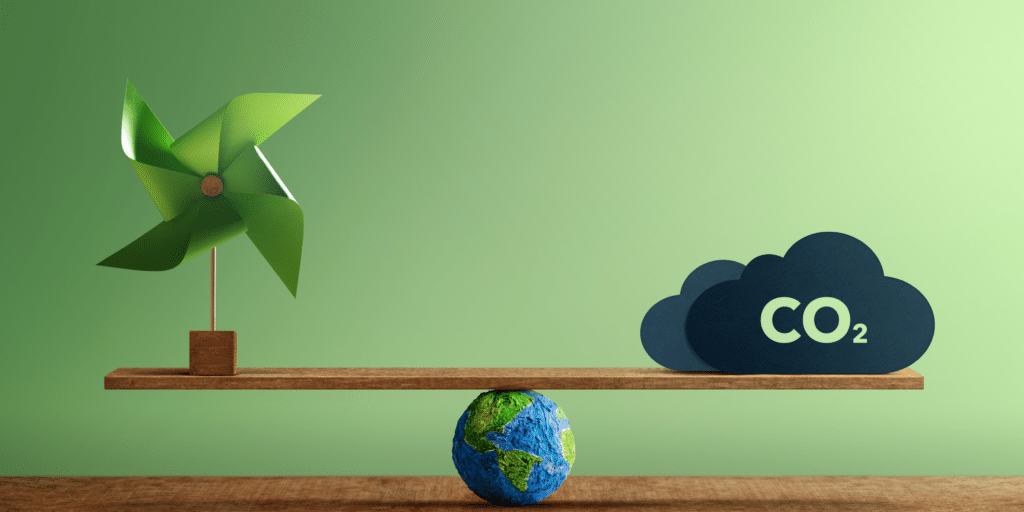Carbon capture and storage (CCS) is a powerful tool in the fight against climate change. The technology allows for the capture and safe storage of significant amounts of carbon dioxide (CO2), preventing its release into the atmosphere. The International Energy Agency estimates that CCS has the potential to reduce global CO2 emissions by 17% by 2050, making it a crucial addition to countries’ global warming mitigation plans. This article aims to provide a comprehensive understanding of the CCS process, its challenges, and its potential benefits. It will also discuss the Global Status of CCS Report 2022 and the pros and cons of onboard carbon capture for the shipping industry.
Carbon Capture and Storage: A powerful tool in the fight against climate change
Carbon capture and storage (CCS) is a process that allows us to capture significant amounts of carbon dioxide (CO2) and safely store it, preventing its release into the atmosphere. As a result, CCS is a powerful tool in humanity’s efforts to mitigate climate change.
The International Energy Agency has claimed that CCS has the potential to reduce global CO2 emissions by 17% by 2050, making it a crucial addition to countries’ global warming mitigation plans. The landmark Paris Agreement has set the tone as an international call to action to keep global temperature rise this century below 2 degrees Celsius above pre-industrial levels or even further to 1.5 degrees Celsius. Studies suggest that the level of parts per million (ppm) of CO2 in the atmosphere is closely correlated with global temperature, underscoring the importance of CCS and other sequestration technologies.
With the devastating effects of climate change becoming increasingly apparent every day, few technologies can have the impact that CCS has. The fact that CCS is a proven technology with a track record of over 40 years and its ability to reduce emissions and capture CO2 directly from the atmosphere should place it at the forefront of our actions. The 2022 Global Status of CCS report published by the Global CCS Institute shows a 44% increase in CO2 capture capacity in the last 12 months, heavily driven by private equity investing heavily in CCS projects in response to the public’s demand for net-zero practices. However, certain challenges limited the hype that CCS technologies had 15 years ago. Finally, even if CCS achieves its full potential, many actions remain to be taken to achieve our climate targets.
Understanding the Carbon Capture and Storage (CCS) Process
Many studies and scientific research have been conducted to find methods to address the increasing concentrations of greenhouse gases (GHG) in the atmosphere, especially carbon dioxide (CO2). The concept of Carbon Capture and Storage (CCS) was introduced in 1977, suggesting that CO2 can be captured from the source and injected into a suitable geological formation.
1. Capture
Carbon capture activities can be distinguished as point-source or direct atmospheric capture. Point-source capture involves capturing CO2 directly from a large quantity-emitting source, while direct capture from the atmosphere involves capturing CO2 from the air. Several proven methods exist, and the choice depends heavily on the emissions source. The three major capture methods are:
- Pre-combustion – converts fuel to CO2 and hydrogen and then separates them, allowing hydrogen to burn and redirect CO2 in storage. It is a complex process, making the technology difficult to apply in existing emitters.
- Oxyfuel combustion uses oxygen instead of air for fuel combustion, creating water vapor and CO2 as byproducts, which can be easily captured.
- Post-combustion – the CO2 is separated from the exhaust gases using several proven techniques, such as chemical absorption, absorption, membrane separation, cryogenic separation, etc
2. Transport
Once the CO2 is cleared of other gases or particles, it is pressurized and liquefied to facilitate its transfer. Pipelines remain the primary means of transporting liquefied CO2, with ships being the alternative, although their popularity is rising.
3. Storage
Transported CO2 is injected under high pressure to one kilometer or more depths in suitable geological storage sites. Depleted oil and gas fields are excellent candidates since they have stored gases for millions of years. Numerous safeguards are in place to monitor and verify that CO2 remains safely and permanently stored.

The stages of the CCS process prove that each step has its challenges. A coordinated effort between the private and public sectors is needed to create the ecosystem allowing this powerful technology to grow.
The rapidly growing landscape of CCS projects worldwide aligns with Government initiatives.
Demand for emission reduction services is rising as the carbon budget consistent with climate targets is depleted, according to the 2022 Global Status of CCS report published by the Global CCS Institute. Throughout the previous year, prominent leaders in CCS-related policy from North America, Europe, and the UK have retained or strengthened their positions.
Significant policy and project development
For example, the Infrastructure Investment and Jobs Act was passed in the US, allocating more than $12 billion for CCS and associated projects. In addition, Canada approved a C$2.6 billion tax credit for CCS projects. In Europe, Norway committed NOK1 billion (US$100 million) to assist three sizable blue hydrogen projects.
Furthermore, Denmark pledged €5 billion in CCS subsidies, and four of the seven projects chosen for award preparation under the inaugural call of the European Union’s Innovation Fund were CCS projects. Finally, the UK Government decided on the first two clusters, East Coast and HyNet, from a list of four CCUS low-carbon industrial clusters that will be delivered by 2030.
The pros and cons of onboard Carbon Capture (OCC) for the shipping industry
The shipping industry is now more than ever ready to drive innovation, given its burden of emitting anywhere between 2-3% of global GHG emissions. The IMO has taken considerable actions to decrease shipping’s carbon footprint, creating new regulations that require vessels to be very particular concerning what and how much they emit. A passionate debate has started globally in the quest to find the next maritime fuel with ammonia, hydrogen, and biofuels at the forefront. However, controlling emissions will be significant as long as vessels that burn fossil fuels exist. As a result, maritime stakeholders are looking for ways to reduce CO2 emissions and consequently exploring what Carbon Capture and Storage (CCS) in the shipping domain has to offer.
The pros of Onboard Carbon Capture (OCC)
There are three major capture types for CCS, with the post-combustion route more easily applicable to shipping. This process requires fewer engine modifications and retrofits than the other types. Due to existing onboard constraints, chemical absorption and cryogenic separation have become more popular regarding the capture method. Mitsubishi, Stena Bulk, and EPS are among the stakeholders researching utilizing this powerful tool. There are many benefits of having a system onboard, considering that a 25% reduction in CO2 emissions would make a Suezmax oil tanker fully compliant with the current regulations, and the 2030 targets conditioned to an amendment in policy as current IMO regulations do not recognize CCS as a means of improving the carbon intensity (CII) rating. (Stena Bulk case study).
The cons of Onboard Carbon Capture (OCC)
However, onboard carbon capture inherits some of the limitations that systems ashore have, such as handling and storing CO2. For example, the captured CO2 can be stored either in solid form at -78°C or in liquid form at -50°C, both options coming with their own set of challenges. Additionally, associated infrastructure must be developed to accommodate the utilization or sequestration of captured CO2. Furthermore, retrofitting a vessel to be equipped with an OCC unit is still extremely expensive, requiring substantial capital expenditure for the equipment, increasing the operating expenditure as energy is required to run the process, and adding weight to the vessel results in higher fuel consumption.
All in all, CCS can be a great tool, but considerable research and governmental incentives are required to reduce and subsidize some of the associated costs.

Technology and Net-Zero shipping: A sustainable future
The future of shipping is closely linked to the fight against climate change. As we transition to a new normal where emissions carry high costs, all stakeholders must do their part to achieve a net-zero future. Fortunately, we have technology on our side. For instance, with Sinay’s CO2 Emissions Calculator API, we can track carbon footprints per ton/TEU while following the guidelines of the GLEC Framework. This allows us to plan ahead of time and make informed data-driven decisions.
Conclusion
In conclusion, carbon capture and storage (CCS) technology is a powerful tool in mitigating climate change and has seen significant growth in recent years. Governments and private investors are recognizing its potential and taking action to support its development. Additionally, the shipping industry is exploring onboard carbon capture (OCC) technology to reduce emissions and contribute to global decarbonization efforts. Collaboration and continued research will be crucial to fully realizing the potential of these technologies.
Frequently Asked Questions About Carbon Capture and Storage
CCS is a process that allows for the capture and safe storage of significant amounts of carbon dioxide (CO2), preventing its release into the atmosphere. It is a powerful tool in the fight against climate change.
According to the International Energy Agency, CCS has the potential to reduce global CO2 emissions by 17% by 2050, making it a crucial addition to countries’ global warming mitigation plans.
Each step in the CCS process has its challenges, such as finding suitable geological storage sites, coordinating between the private and public sectors, and high costs.
Onboard carbon capture can reduce CO2 emissions from the shipping industry, but it is expensive and has challenges, such as the need for safe and secure storage, as well as a lack of infrastructure and regulations.
Focus on data to make effective decisions
Discover our modules
Environmental Monitoring
Monitor air quality in real-time, be alerted when a threshold is reached & easily comply with regulation thanks to the automated reports.
Monitor water quality in real-time, predict and avoid water pollution & comply with regulations thanks to the automated reports.
Deliver a preliminary metocean analysis and the associated report in jut a few minutes.
You may also be interested by those others environment application :






